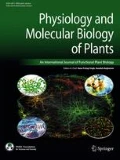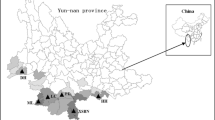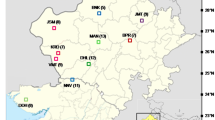Abstract
Genetic diversity existing amongst five Eulophia orchid species were assessed using start codon targeted polymorphism (SCoT) and inter-retrotransposon amplified polymorphism (IRAP) markers. A total of 12 SCoT and 5 IRAP markers revealed an average of 63% genetic variability [SCoT = 63.87; IRAP = 64.95%] amongst the five Eulophia species investigated. The genetic similarities were assessed using both UPGMA and Bayesian approaches which indicated identical clustering patterns at a genetic similarity level of 50%. Analysis of molecular variance (AMOVA) revealed the presence of a significant degree of genetic variability, mostly compartmentalized within the species level. Amongst the five assessed Eulophia species, E. parviflora was the most genetically diverse representative whereas E. welwitschii was found to be least diverse based on a comparative assessment of various population genetic parameters like Nei’s gene diversity (h) and Shannon’s information index (I) with an overall gene flow value greater than 1. In order to evaluate the comparative marker efficiency, SCoT and IRAP marker data were subjected to various benchmark analyses like marker index, resolving power, polymorphic index content, multiplex ratio and effective multiplex ratio which revealed the robustness of both the marker techniques in assessment of genetic diversity. The present report provides the first molecular insights into the aspects of inter and intra specific genetic variability in medicinally as well as horticulturally important Eulophia species along with addressing their conservation concerns. In a nutshell, the present approach is simple, rapid and cost effective and can be extended for analysis of genetic diversity of other related plant species.


Similar content being viewed by others
Abbreviations
- PCR:
-
Polymerase chain reaction
- PIC :
-
Polymorphic information content
- AMOVA:
-
Analysis of molecular variance
- Rp :
-
Resolving power
References
Bhattacharyya P, Kumaria S (2015) Molecular characterization of Dendrobium nobile Lindl., an endangered medicinal orchid, based on randomly amplified polymorphic DNA. Plant Syst Evol 301:201–210
Bhattacharyya P, Van Staden J (2016) Ansellia africana (Leopard orchid): a medicinal orchid species with untapped reserves of important biomolecules—a mini review. S Afr J Bot 106:181–185
Bhattacharyya P, Kumaria S, Kumar S, Tandon P (2013) Start Codon Targeted (SCoT) marker reveals genetic diversity of Dendrobium nobile Lindl., an endangered medicinal orchid species. Gene 529:21–26
Bhattacharyya P, Kumaria S, Tandon P (2015) Applicability of ISSR and DAMD markers for phyto-molecular characterization and association with some important biochemical traits of Dendrobium nobile, an endangered medicinal orchid. Phytochemistry 117:306–316
Bhattacharyya P, Kumaria S, Tandon P (2016) High frequency regeneration protocol for Dendrobium nobile: a model tissue culture approach for propagation of medicinally important orchid species. S Afr J Bot 104:232–243
Bhattacharyya P, Ghosh S, Sen Mandi S, Kumaria S, Tandon P (2017) Genetic variability and association of AFLP markers with some important biochemical traits in Dendrobium thyrsiflorum, a threatened medicinal orchid. S Afr J Bot 109:214–222
Cabo S, Ferreira L, Carvalho A, Martins-Lopes P, Martín A, Lima-Brito JE (2014) Potential of Start Codon Targeted (SCoT) markers for DNA fingerprinting of newly synthesized tritordeums and their respective parents. J Appl Genet 55:307–312
Chen L, Zhao L, Bai Y, Hu R, Si J (2009) Genetic relationship analysis of different provenances of Leonurus japonicus by ISSR marker. China J Chin Mater Med 34:1343–1345
Chinsamy M, Finnie JF, Van Staden J (2011) The ethnobotany of South African medicinal orchids. S Afr J Bot 77:2–9
Chowdhery HJ (2001) Orchid diversity in North-east India. J Orchid Soc India 15:1–17
Collard BCY, Mackill DJ (2009) Start codon targeted (SCoT) polymorphism: a simple, novel DNA marker technique for generating gene-targeted markers in plants. Plant Mol Biol Rep 27:86–93
Cunningham AB (1988) An investigation of the herbal medicine trade in Natal/KwaZulu. Institute of Natural Resources, University of Natal, Pietermaritzburg
Ellstrand NC, Elam DR (1993) Population genetic consequences of small population size: implications for plant conservation. Annu Rev Ecol Syst 24:217–242
Evanno G, Regnaut S, Goudet J (2005) Detecting the number of clusters of individuals using the software STRUCTURE: a simulation study. Mol Ecol 14:2611–2620
Excoffier L, Laval G, Schneider S (2005) Arlequin (version 3.0): an integrated software package for population genetics data analysis. Evol Bioinform Online 1:47
Falush D, Stephens M, Pritchard JK (2003) Inference of population structure using multilocus genotype data: linked loci and correlated allele frequencies. Genetics 164:1567–1587
Falush D, Stephens M, Pritchard JK (2007) Inference of population structure using multilocus genotype data: dominant markers and null alleles. Mol Ecol Notes 7:574–578
Feng S, He R, Yang S, Chen Z, Jiang M, Lu J, Wang H (2015) Start codon targeted (SCoT) and target region amplification polymorphism (TRAP) for evaluating the genetic relationship of Dendrobium species. Gene 567:182–188
Gepts P (2002) A comparison between crop domestication, classical plant breeding, and genetic engineering. Crop Sci 42:1780–1790
Gerstner J (1941) A preliminary check list of Zulu names of plants: with short notes. Bantu Stud 15:277–301
Graner A, Dehmer KJ, Thiel T, Börner A (2004) IV. Plant genetic resources: benefits and implications of using molecular markers. Evol Role Genebanks Fast-developing F Mol Genet Genet Resour No 11, 26 Aug 2004
Gupta PK, Varshney RK, Prasad M (2002) Molecular markers: principles and methodology. In: Molecular techniques in crop improvement. Springer, pp 9–54
Hamrick JL, Godt MJW (1996) Effects of life history traits on genetic diversity in plant species. Philos Trans R Soc Lond Ser B Biol Sci 351:1291–1298
Holsinger KE, Mason-Gamer RJ, Whitton J (1999) Genes, denies, and plant conservation. In: Landweber LF, Dobson AP (eds) Genetics and the extinction of species. Princeton University Press, Oxford, pp 23–46
Hulme M (1954) Wild flowers of Natal. Shuter & Shooter, Pietermaritzburg
Hutchings A (1996) Zulu medicinal plants: an inventory. University of Natal Press, Pietermaritzburg
Jin WT, Yao SP (2006) Cultivation and appreciation of noble Spring Orchid cultivars. Guangdong Science and Technology Press, Guangzhou, China
Kalendar R, Schulman AH (2006) IRAP and REMAP for retrotransposon-based genotyping and fingerprinting. Nat Protoc 1:2478–2484
Kalendar R, Grob T, Regina M, Suoniemi A, Schulman A (1999) IRAP and REMAP: two new retrotransposon-based DNA fingerprinting techniques. Theor Appl Genet 98:704–711
Lande R (1999) Extinction risks from anthropogenic, ecological and genetic factors. In: Landweber LF, Dobson AP (eds) Genetics and the extinction of species. Princeton University Press, pp 1–22
Landry BS, Li RQ, Cheung WY, Granger RL (1994) Phylogeny analysis of 25 apple rootstocks using RAPD markers and tactical gene tagging. Theor Appl Genet 89:847–852
Li A, Ge S (2006) Genetic variation and conservation of Changnienia amoena, an endangered orchid endemic to China. Plant Syst Evol 258:251–260
Manners V, Kumaria S, Tandon P (2013) SPAR methods revealed high genetic diversity within populations and high gene flow of Vanda coerulea Griff ex Lindl (Blue Vanda), an endangered orchid species. Gene 519:91–97
Martos F, Johnson SD, Peter CI, Bytebier B (2014) A molecular phylogeny reveals paraphyly of the large genus Eulophia (Orchidaceae): a case for the reinstatement of Orthochilus. Taxon 63:9–23
Maunder M, Culham A, Alden B, Zizka G, Orliac C, Lobin W, Bordeu A, Ramirez JM, Glissmann-Gough S (2000) Conservation of the Toromiro tree: case study in the management of a plant extinct in the wild. Conserv Biol 14:1341–1350
Mehra PN, Khosla PK (1973) Cytological studies of Himalayan Rutaceae. Silvae Genet 22:182–188
Miller MP (1998) AMOVA-PREP 1.01: a program for the preparation of AMOVA input files from dominant-markers raw data. Comput Softw Distrib 22:927–934
Milligan BG, Leebens-Mack J, Strand AE (1994) Conservation genetics: beyond the maintenance of marker diversity. Mol Ecol 3:423–435
Mulpuri S, Muddanuru T, Francis G, Sujatha M, Tarakeswari M, Francis G (2013) Start codon targeted (SCoT) polymorphism in toxic and non-toxic accessions of Jatropha curcas L and development of a codominant SCAR marker. Plant Sci 207:117–127
Muñoz M, Warner J, Albertazzi FJ (2010) Genetic diversity analysis of the endangered slipper orchid Phragmipedium longifolium in Costa Rica. Plant Syst Evol 290:217–223
Nekrutenko A, Makova KD, Baker RJ (2000) Isolation of binary species-specific PCR-based markers and their value for diagnostic applications. Gene 249:47–51
Nybom H (2004) Comparison of different nuclear DNA markers for estimating intraspecific genetic diversity in plants. Mol Ecol 13:1143–1155
Powell W, Morgante M, Andre C, Hanafey M, Vogel J, Tingey S, Rafalski A (1996) The comparison of RFLP, RAPD, AFLP and SSR (microsatellite) markers for germplasm analysis. Mol Breed 2:225–238
Pritchard JK, Stephens M, Donnelly P (2000) Inference of population structure using multilocus genotype data. Genetics 155:945–959
Rohlf JF (1998) NTSYS pc, numerical taxonomy and multivariate analysis system version 2.0 user guide. Setauket
Sharma SK, Kumaria S, Tandon P, Rao SR (2011) Single primer amplification reaction (SPAR) reveals inter-and intra-specific natural genetic variation in five species of Cymbidium (Orchidaceae). Gene 483:54–62
Shimada T, Hayama H, Haji T, Yamaguchi M, Yoshida M (1999) Genetic diversity of plums characterized by random amplified polymorphic DNA (RAPD) analysis. Euphytica 109:143–147
Slatkin M (1987) Gene flow and the geographic structure of natural. Science 236:787–792
Slatkin M, Barton NH (1989) A comparison of three indirect methods for estimating average levels of gene flow. Evolution (NY) 43:1349–1368
Smith JSC, Chin ECL, Shu H, Smith OS, Wall SJ, Senior ML, Mitchell SE, Kresovich S, Ziegle J (1997) An evaluation of the utility of SSR loci as molecular markers in maize (Zea mays L.): comparisons with data from RFLPs and pedigree. Theor Appl Genet 95:163–173
Sneller CH, Miles JW, Hoyt JM (1997) Agronomic performance of soybean plant introductions and their genetic similarity to elite lines. Crop Sci 37:1595–1600
Soorni A, Nazeri V, Fattahi R, Khadivi-Khub A (2013) DNA fingerprinting of Leonurus cardiaca L. germplasm in Iran using amplified fragment length polymorphism and inter-retrotransposon amplified polymorphism. Biochem Syst Ecol 50:438–447
Swarts ND, Dixon KW (2009a) Terrestrial orchid conservation in the age of extinction. Ann Bot 104:543–556
Swarts ND, Dixon KW (2009b) Perspectives on orchid conservation in botanic gardens. Trends Plant Sci 14:590–598
Swarts ND, Sinclair EA, Krauss SL, Dixon KW (2009) Genetic diversity in fragmented populations of the critically endangered spider orchid Caladenia huegelii: implications for conservation. Conserv Genet 10:1199–1208
Tong-Jian S, Liu-Qin Z, Xin S (1991) A marker-coupled method for site-directed mutagenesis. Gene 103:73–77
Wang HZ, Wu ZX, Lu JJ, Shi NN, Zhao Y, Zhang ZT, Liu JJ, Zhang ZT, Liu JJ (2009) Molecular diversity and relationships among Cymbidium goeringii cultivars based on inter-simple sequence repeat (ISSR) markers. Genetica 136:391–399
Waugh R, McLean K, Flavell AJ, Pearce SR, Kumar A, Thomas BBT, Powell W (1997) Genetic distribution of Bare–1-like retrotransposable elements in the barley genome revealed by sequence-specific amplification polymorphisms (S-SAP). Mol Gen Genet MGG 253:687–694
WCSP (2016) World Checklist of Selected Plant Families. Facilitated by the Royal Botanic Gardens, Kew. http://apps.kew.org/wcsp/. Accessed 20 June 2016
Xiong F, Zhong R, Han Z, Jiang J, He L, Zhuang W, Tang R (2011) Start codon targeted polymorphism for evaluation of functional genetic variation and relationships in cultivated peanut (Arachis hypogaea L.) genotypes. Mol Biol Rep 38:3487–3494
Yeh FC, Yang R-C, Boyle T (1999) PopGene version 1.31: Microsoft window-based freeware for population genetic analysis. University of Alberta, Edmonton
Yu Q, Sheng XX, Sheng YF et al (2009) AFLP Analysis of genetic diversity of Leonurus japonicus germplasm resources. Chin Tradit Herb Drugs 40:1296–1299
Acknowledgements
Paromik Bhattacharyya thanks the University of KwaZulu-Natal (UKZN), South Africa for support in the form of a Postdoctoral Fellowship.
Author information
Authors and Affiliations
Corresponding author
Electronic supplementary material
Below is the link to the electronic supplementary material.
Rights and permissions
About this article
Cite this article
Bhattacharyya, P., van Staden, J. Molecular insights into genetic diversity and population dynamics of five medicinal Eulophia species: a threatened orchid taxa of Africa. Physiol Mol Biol Plants 24, 631–641 (2018). https://doi.org/10.1007/s12298-018-0523-6
Received:
Revised:
Accepted:
Published:
Issue Date:
DOI: https://doi.org/10.1007/s12298-018-0523-6




